The number of Samurai swords found in the US is greater than those found in Japan. After WWII. US soldiers
captured and brought back many swords. The item featured here is one of the swords that was brought back.

Sword and scabbard are positioned side by side. Most blades were under 30 inches in length,
however, some swords reached lengths of 31 to 32 inches. The blade on this sword is fairly old
but it is not in the best condition. This fact hurts the value of the item.
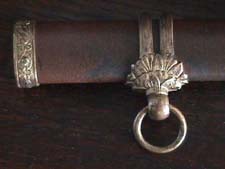
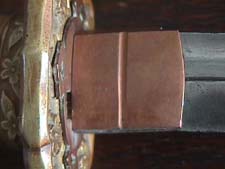
This picture provides a good example of WWII fittings which include: The fuchi
, decorative band on the left side. A side view of the tsuba or hand guard and
the kuchigane, which is the throat fitting located to the right of the tsuba.
The kuchigane on this photograph is secured to the scabbard by a screw.
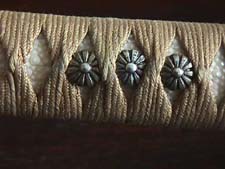
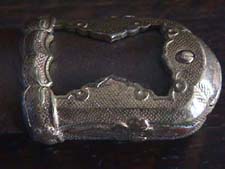
The manuki (handle ornament) displayed on the picture on the left is not an original piece.
It appears that at one point the fittings of this sword were replaced. The picture on the right shows
the piece attached to the bottom of the scabbard.
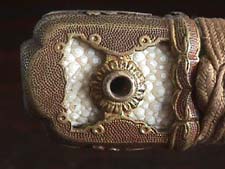
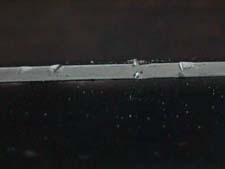
Close up picture of the kabutogane or pommel. This piece is painted in
military brown colors. A cloth sling would be threaded through the opening on the
pommel. The picture on the right provides a view of the top of the blade. What is interesting about
this sample is that it has several nicks that appear to have been made by another sword. When a Samurai
engaged in combat he would block the opponents blade with the top of his sword so as to avoid damage to
the cutting edge.
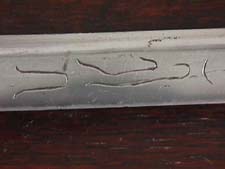
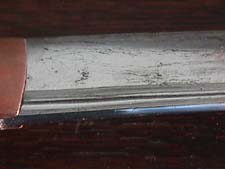
Unknown marks inscribed on the blade itself. Notice the grinder marks on the blade.
Unfortunately but a common occurance, many of the GIs who brought the swords back to the U.S.
sharpened them the way a regular knife would have been sharpened, causing severe damage to
the blade. The picture on the right shows the Ito groove. The purpose of the groove is to lighten the blade
and is a common feature seen on modern day Iaito blades which never touch blood. This feature can be confused with
a blood groove. However, blood groves are employed in stabbing weapons to allow increased
blood flow from the wound, a katana is predominantly a cutting weapon and would be
unlikely to need a blood grove and many do not. Also featuring a Ito groove can
slightly compromise the strength a blade to resist a blow from another sword so were
only ever added to lighten a blade to make it more manoeuvrable for some one of less
strength.
This Samurai Sword may be currently reproduced.
It is becoming more difficult to be able to tell the fake ones from the real ones because
the quality of the reproductions is improving. The collector must become familiarized with
the construction style and materials employed in the manufacturing of this item.
Attention to the details is critical in order to be able to determine the authenticity of
the collectible.
If you have an interest is seeing other Japanese Samurai swords, you can do so by going to our
Japanese Samurai Swords Price Guide
identification guide. Where we cover Samurai swords from all periods.
| 




